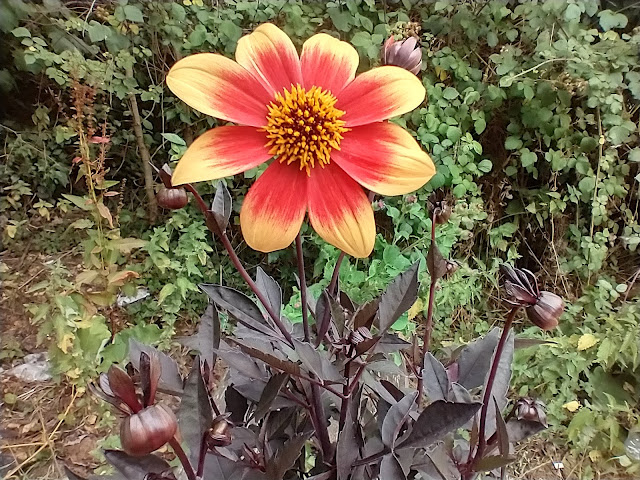An Evening With Bob Brown Part II
 Last week I summarised Bob Brown's reasons why perennials often don't propagate well via seed. This time I'm summarising the remaining top tips from his recent talk at Bath University Gardening Club.
Last week I summarised Bob Brown's reasons why perennials often don't propagate well via seed. This time I'm summarising the remaining top tips from his recent talk at Bath University Gardening Club.
Bob took us through a month by month tour of some of his favourite plants and the best way he's found to propagate them. Sadly we only had time to get to May!
Propagation
- January: Sarcococca confusa - an example of a perennial which can be propagated from seed - found in the plant's black berries. Sow fresh after cleaning them, on top of compost and top dress with grit (the latter prevents algal growth)
- February: Miscanthus x Giganteus - divide plants when they're just about to start to grow. This allows the plants to grow out of the stress from division
- February: Snowdrops - divide clumps of bulbs into smaller ones and replant. This can be done pretty much at any time, but avoid dry bulbs. Another recommended propagation method is twin-scaling, but this is best when the bulb is starting to grow. For snowdrops this is August/September time. Also ensure a portion of the bulb's basal plate is included in each scale
- March: Salvia nemorosa 'Caradonna' - Bob told us this plant has very recently been awarded the RHS AGM. It grows from a single stem, so is unsuitable for division. Bob finds these are best propagated via basal cuttings
- April: Arisaema candidissimum - another candidate for division by Bob, though the link given recommends seed or planting up offsets in the autumn
- May: Agapanthus 'Jack's Blue' and Kniphofia 'H. E. Beale' - division
- May: Tibouchina urvilleana - softwood cuttings i.e. from the tip of the new season's growth
- The propagation method chosen and timing are designed to provide the least amount of stress to the plant. Thus avoid flowering times (because the plant is concentrating on reproducing itself) and the end of the growing season (the plant won't get a chance to grow away strongly afterwards)
- Softwood, semi-ripe and hardwood cuttings are essentially taken from the same season's growth, but the type of cutting obtained depends on the time of year. Thus softwood cuttings are usually taken up to mid-summer; semi-ripe (tip is soft, but the base is hard) from late summer to mid-autumn; and hardwood (all the cutting is hard) from mid-autumn to late winter, often when the plant is dormant
- If only leaves are obtained when pulling up a bulb, these can be potted up and a bulb will form
- When dividing potted plants, take them out of the pot and divide from the bottom of the roots upwards. This minimises stress on the plant and ensures less plant material is wasted
- Bob doesn't use peat based composts as there's problems with sciarid fly if he does and seedlings don't grow so strongly
- There's no need to use hormone rooting powder with cuttings - he and his staff have found it makes no different to the end result
- Using pot feet under overwintering pots leads to waterlogging. Apparently leaving pots standing on soil or concrete allows excess water to be wicked away. I haven't had any problems with not using them either. Bob also said using broken pots and polystyrene in the pots may also lead to waterlogging
- The nursery cat is tax deductible!
Sadly Bob only spoke for an hour and we all could have listened for a lot longer. Tim Matcham was also there - here's his view on the evening :)










Sounds like you had a thoroughly entertaining and educational evening! Love all the tips you've come back with: I didn't know top dressing with grit prevented algae or that fungal gnats were worse with peat based compost, both of which I'll bear in mind. (Yes, I am trying to avoid peat based compost but will now try harder!)
ReplyDeleteCaro - it was a great evening :) Bob has a very dry sense of humour which sadly I didn't capture in my frenzied note taking. The tax deductible cat is just 1 example from many.
ReplyDeleteI thought the peat remark was a good one to include as it shows there are other sound reasons not to use it for those not convinced by the environmental ones.
One week in and going strong. Bath University Garden Club sounds posh!
ReplyDeleteSounds like one of those talks where you get cramp you are writing so fast trying to capture everything! I am envious...
ReplyDeleteSounds as though it was a very interesting talk - thanks for giving us a summary. I didn't know about new bulbs forming just from leaves, or that pot feet increase likelihood of waterlogging - I don't use them but have often wondered whether I should.
ReplyDeleteMark - thanks and so are you. The club's open to anyone interested in gardening and gets top notch speakers :)
ReplyDeleteJanet - you almost didn't get the last plant because my handwriting was illegible. Luckily the first 3 letters of the name (and how unusual it is) were enough for me to be able to find it in one of my plant books.
Juliet - I can't wait to try that one out as my impatience when digging bulbs up often means I end up with a hand full of leaves somewhere down the line. Like you, I'd wondered about getting some pot feet, but in future I can remember Bob telling us they're a marketing ploy whenever I'm tempted